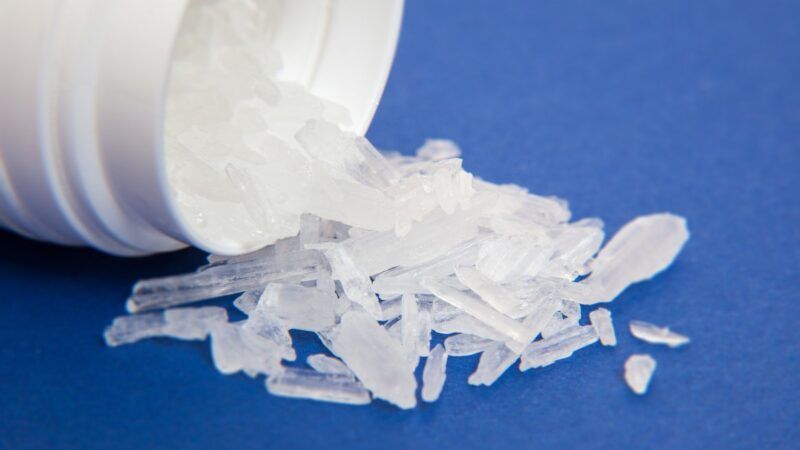The New York Times Credulously Embraces the 'Super Meth' Theory
There is no solid evidence that P2P meth is more dangerous than pseudoephedrine-derived meth and no reason to think it would be.

A story about polysubstance use in today's New York Times mentions "super meth" four times: once in the headline, once in a subhead, and twice in the body text. "A decade or so ago, Mexican drug lords figured out how to mass-produce a synthetic 'super meth,'" Times reporter Jan Hoffman writes. "It has provoked what some researchers are calling a second meth epidemic. Popular up and down the West Coast, super meth from Mexican and American labs has been marching East and South and into parts of the Midwest."
Yet Hoffman never explains what "super meth" means. Instead she links to a widely cited 2021 article in The Atlantic by journalist Sam Quinones. In that piece, which is based on Quinones' 2021 book The Least of Us, he posits that methamphetamine derived from phenyl-2-propanone (P2P), the dominant method nowadays, is more potent and more hazardous than methamphetamine derived from pseudoephedrine, a process that became less common after the U.S. government restricted access to that precursor.
If that were true, it would be yet another illustration of prohibition's tendency to make drug use more dangerous: By cracking down on cold and allergy medications containing pseudoephedrine, the government pushed production abroad and encouraged traffickers to use P2P instead, which, according to Quinones, made the resulting methamphetamine purer, more addictive, more physically harmful, and more likely to trigger "mental illness"—so much so that, according to the headline over his Atlantic article, it might not even make sense to "call it meth anymore." But although Hoffman evidently considers Quinones a credible source, he never offered a plausible reason to believe any of that.
As drug historian David Herzberg notes in a Washington Post review of Quinones' book, "Quinones has no laboratory or epidemiological evidence that P2P meth is different from ephedrine-produced meth—the 'super-meth' theory is based entirely on anecdotes." Herzberg adds that "journalists were writing equally terrifying things about 'crack' cocaine and ephedrine-based meth (and heroin) back in the 1980s and 1990s."
Quinones himself is hazy on the scientific basis for his theory. "No one I spoke with knew for sure" why "P2P meth" was "producing such pronounced symptoms of mental illness in so many people," he says.
Claire Zagorski, a paramedic who teaches harm reduction at the University of Texas at Austin College of Pharmacy, questions the assumption underlying that question. "We have no evidence supporting the idea that the meth currently on the market is meaningfully different at a population level," she writes in Filter, "or that P2P-produced meth is any more or less neurotoxic than ephedrine meth." Nor is that surprising, since "all meth actually has the same chemical makeup," and "the only difference is the production method."
Hoffman avers that "super meth" packs "a potentially lethal, addictive wallop far stronger" than ephedrine-based meth. But on the face of it, you would expect the latter method to produce more potent methamphetamine—exactly the opposite of what Hoffman and Quinones are claiming. An "ephedrine/pseudoephedrine reduction," the Drug Enforcement Administration notes, yields "high quality d-methamphetamine," the psychoactive isomer, without unwanted l-methamphetamine. The P2P method, by contrast, "yields lower quality dl-methamphetamine," a combination of the two isomers.
Quinones concedes that P2P-derived meth is not actually a new thing, noting that "the Hell's Angels and other biker gangs" used this method before phenyl-2-propanone, which was placed on Schedule II of the Controlled Substances Act in 1980, became harder to come by. In his telling, the key development in the marketing of P2P meth happened sometime around 2006, when Mexican cartels figured out how to "separate d-meth from l-meth," which he describes as "tricky" and "beyond the skills of most clandestine chemists." In reality, Zagorski says, "isomer separation is fairly teachable" and "not all that mysterious":
The cleanest and most straightforward way to remove the L from the psychoactive D isomer is capillary electrophoresis. This process involves feeding a meth sample into a small capillary tube and exploiting differences between the two isomers that cause one to "stick" to the tube's coating while the other continues on. Anyone with around $4,000 can do this with via a capillary electrophoresis machine, which automates the process to minimize human error and labor.
However challenging the process, it is necessary only because the P2P method yields an inferior mixture compared to the "high quality d-methamphetamine" produced by the pseudoephedrine method. Either way, Zagorski notes, the goal is something like "pharmaceutical-grade meth, the regulated version of which is sold under the brand name Desoxyn." Yet that "FDA-approved prescription form" of the drug "doesn't cause 'cerebral catastrophe'" involving the "violent paranoia, hallucinations, conspiracy theories, isolation, massive memory loss, [and] jumbled speech" that Quinones describes.
Unfazed by the lack of such symptoms in patients who take Desoxyn, Quinones asserts that "methamphetamine is a neurotoxin" that "damages the brain no matter how it is derived." Still, he says, "P2P meth seems to create a higher order of cerebral catastrophe."
Why would that be? "One theory is that much of the meth contains residue of toxic chemicals used in its production, or other contaminants," Quinones writes. "Even traces of certain chemicals, in a relatively pure drug, might be devastating."
The problem, in other words, is not that P2P meth is especially pure but rather that it contains potentially "devastating" contaminants. Maybe.
Or maybe not. "The sheer number of users is up, too, and the abundance and low price of P2P meth may enable more continual use among them," Quinones says. "That, combined with the drug's potency today, might accelerate the mental deterioration that ephedrine-based meth can also produce." That explanation, however, has nothing to do with the inherent properties of P2P-derived methamphetamine, contrary to the "super meth" theory that The New York Times has credulously embraced.
Show Comments (54)